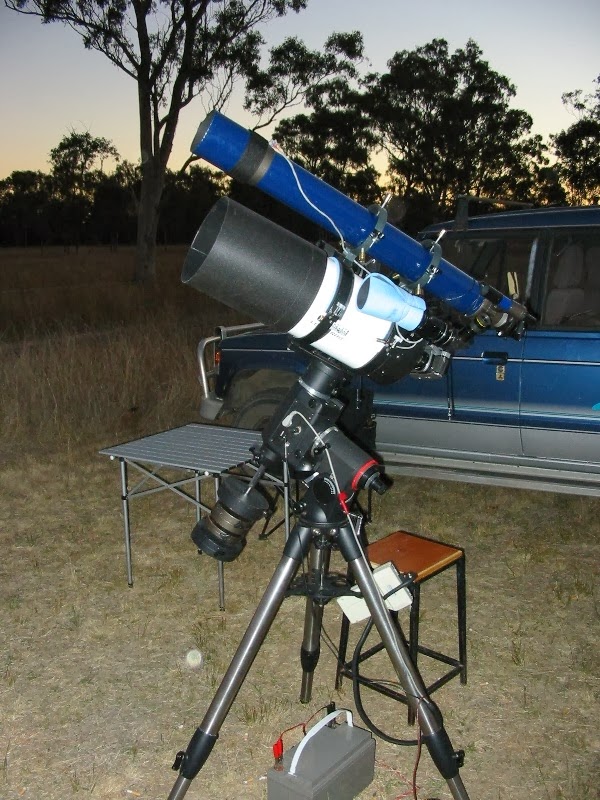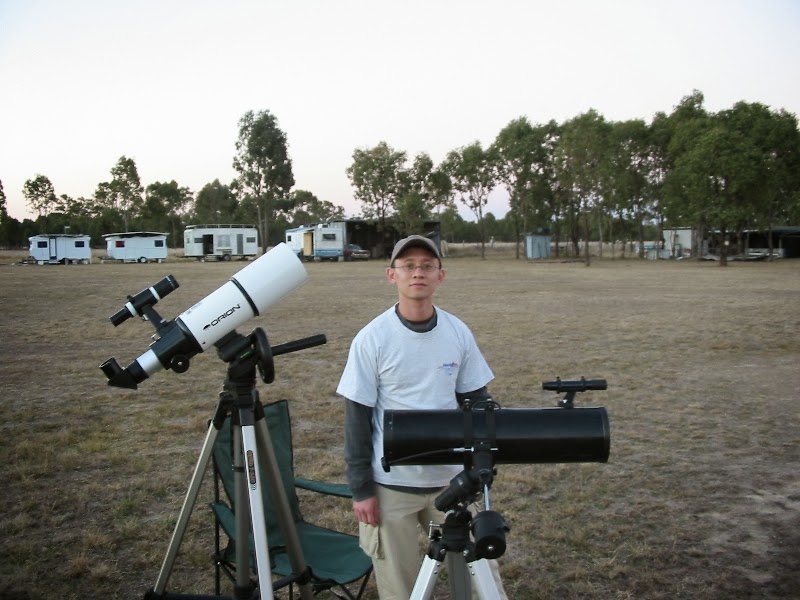"Leyburn in the early days. Barren field's, large dobs and EQ mounts.....this was my first trip to Leyburn. All three of us packed our gear (and ourselves) into David's Trooper (seen behind Andrew's York Optical 6" f/5 on NES EQ3 mount...similar mount to Orion's SkyView deluxe mount). Center piccie shows David's 10" f/5 GS dob and his then imaging scope 6" Synta refractor on EQ5 mount"
The lousy weather the past couple of weekend's allowed me time to ponder, read my new kindle book "Southern Gems" by Stephen O'Meara and to reminisce about observing locales and times gone by. One of my favourite observing places is Leyburn, Queensland, Australia. If there ever was a paradise on earth for amateur astronomers, the Southern Astronomical Society's dark sky site would surely rank up there as one of the best places in Australia (for me anyway, unless you are out in the boonies and deserts, but then those are not accessible on a regular basis). I remember my first visit to this wonderful site. Thanks to my awesome observing buddy Andrew Durick, who was the first person to welcome me to observing down under. It was Andrew who introduced me to Leyburn and my second real observing buddy David Rigley. I remember fondly the first few months back in oz in 2001 where all I had was a lowly 76mm f/9 navy blue alt-az mounted newtonian, a scope which showed me heaps more than I could have imagined from the darker skies in and around Brisbane. This scope gave me my first "in depth" look at two of my fave winter objects, M57; The Ring Nebula and M27; the Dumbbell Nebula, and from my apartment balcony in Vincent Street, Indooroopilly no less. The skies were heaps darker in the early 2000's. The winter milky way showed structure in the wee hours of the morning when all the lights went out! having two balconies made a big difference, coupled with the fact that the balconies only had beams and no roofing.
"Leyburn in 2004. Still early days and barren fields. We always occupy the same space when we go together. Andrew and his newly acquired 102ST on the York Optical NES mount from his 6"f/5. David was using a slighly different setup with a Celestron C8 as the main imaging scope and 4" Synta as a guide scope. Note that he was still doing film photography back then. Last pic shows our side of the observing field. Ray standing far left, David seated in the middle and me surrounded by my Celestron/Vixen C6, Andrew's 102ST and my 15x70 binoculars. I traveled with Andrew on several of our outings to Leyburn. He would come pick me up after lunch from UQ and we would swing around to my place at Vincent Street and then start our journey...ah fond memories all!"
The first gathering we ever had was at David's house in a rather light polluted part of town. This was a real eye opener for me. Andrew had his York Optical 6" f/5 on NES EQ 3 mount, and David had his 10" f/5 GS and 6" Synta refractor mounted on an EQ5. Its funny how Andrew's 6" f/5 EQ was more collapsible and easy to transport than my 76mm f/9 alt-az newtonian, as the OTA and the mount would not come apart. It was heaps lighter though. In the early days, David did all the driving to Leyburn. We packed whatever gear we had into his Trooper. Andrew had this 6"f/5 EQ, and I had my 6" Bird Jones EQ which I purchased new in late 2001, with the help of my significant other. David usually had with him his imaging rig, which he had to cart out there. He also brought along a "spare" visual scope (the 10" GS scope which ironically had an Orion labeled eyepiece rack and dust cover (yup the first generation spring loaded GS dobsonian's (the ones with the non dovetail finders) were made by GS in Taiwan, the later batches were made by Synta) with him, and that usually ended up getting used by either me or Andrew. In the old days he imaged with film and used mostly his Synta refractors (he had a 6" and a 4" long focal length refractor), as well as his white tube Celestron C8 on EQ5 mount (and later on a Atlas clone mount).
"Much later years at Leyburn at the peak of winter (yes never again will I go in July.....frost covered everything and I had to wait for my car and scope to thaw out. Notice the same spot where we usually gather. The bottom pic shows Ray (left) and David's (right with his white truck) shed observatories......everyone does digital imaging now! Truss dobs have been replaced by precise GOTO mounts, DSLR's and CCD camera's! Third image on the top right shows the campervan that houses the bunk beds and the kitchen where the mini library lives!"
Sessions usually lasted a night and we usually got there before sundown, set our scopes up, check the collimation and the finderscope alignment. Then it was chill time, where we would either sit down and grab a bite, plan our observing for the night or walk around and inspect other telescopes (mostly large truss dobsonians). Boy how times changed. I remember seeing the transition from a barren field covered with truss dobs, to concrete slabs being erected one by one, as more people turned to astro imaging. In the old days we had David imaging with either his 6" Synta, or C8, and Ray Suckling doing wide field imaging, with Kevin Dixon showing us the night sky treasures through his 16" truss dob. Those were the people I hung around the most with, even while I was crazily hunting down objects on my to do list (which frequently numbered in the 20's or more per session!). There was the occasional large scope treat when Pete Robbin's brought his 30" SDM to the field. Those were some crazy awesome nights! It was here that I had my first real taste of truly dark skies. It was also here that I first learnt of the great celestial emu, which stretched from the coal sack at the bottom of the Crux, all the way through Puppis-Pyxis, and saw the wonders of the south like the great Tarantula Nebula, or Kevin's starfish glob (Pavo glob NGC 6752) and spiral planetary in Musca (NGC 5189), and of course the Magellanic Clouds.
"Leyburn in the hotter months means mozzies that bite through even jeans, balmy to warm weather and camping tents out in full force! From left to right, Andrew's 12.5" truss dob (Ray's observing shed-white and David's imaging shack-green can be seen in the background), my 10" GS and StarBlast 4.5" dobs.....and my old faithful Hyundai Excel hatchback."
I remember the anticipation of getting there and how we would even risk going there when stormclouds were a brewing (seeing that Leyburn is 2 1/2 hour drive one way up and down the Toowoomba ranges, which helped with shielding the bright lights of Brisbane!). There were a couple of sessions where Andrew and I would go, only to get 1 or 2 hours of sucker hole observations, but we still went. Such was our resolve. The early days also saw us sleeping in the guest campervan. The campervan had poor insulation and only had three bunk beds (slept 6). I remember getting very bad sleep due to snoring and being very cold. The later trips saw us setting up our own tents or even sleeping in our own cars when it got too cold. I also spent mornings in the adjoining part of the campervan that had cooking facilities and a mini library. Spend some mornings just perusing the nice collection of Astronomy and Sky and Telescope magazines and taking a trip down memory lane with some of those old issues. They even had japanese telescope magazines (I think it was called Tenba) and a copy or of the HB atlas. Ah those were some magical times. At that stage, I never though I would someday move to the northern hemisphere for work. I though I would be observing from southern skies for as long as I lived! I spent a total of 9 years observing from Leyburn (averaging at least 9 to 10 months a year, weather depandant). So many wonderful memories observing under pitch black skies with wonderful friends.


"Leyburn in different seasons. We even setup our tents in the winter...call us crazy ;) The bottom left piccy shows David's imaging rig in his coldroom observatory (yup it was literally a torn down cold room so it offered excellent insulation during the winter months. David was also a big music fan so we usually observed to tunes wafting through from his observatory). Main imaging scope is the C8, with the WO 65 providing wide field shots and guiding. Bottom right pic shows Andrew with his main scope, the 12.5" truss, and his wide field scope."
Alas that was not to be. Jobs and opportunities in my line of work are few and far between in Australia, largely due to research funding. California is the place to be for biotechnology. Granted that it is also a sunshine state, the number of clear skies per year here is staggering. Also since California is largely desert, getting to dark skies is a non issue for me. But the southern skies can never be replaced, and will always hold a special place in my heart. I remember my first truly dark sky moment here in SoCal. It was at Mount Pinos. Skies were dark, close to what we get in Leyburn (largely due to the presence of the marine layer, which is not always present). But I found the northern milky way severely lacking in many aspects. There were no "WOW" objects in the northern skies. As such I found myself once again pining for the southern gems and going south and revisiting the center of our milky way, which skims the pine tree tops in Pinos. Objects I really and truly miss are:
- Eta Carina Nebula and surrounds
- Omega Centauri
- 47 Tucana
- NGC 6752
- NGC 6397
- Tarantula Nebula
- NGC 5189 Musca Spiral Planetary
- Coal Sack
- Large Magellanic Cloud
- Small Magellanic Cloud
Someday I will return to the land down under, even if it is just for a visit. But Brisbane and Queensland will always have a special place in my heart. Who knows maybe someday I will retire there.....as they say where there is life, there is hope........
"The evolution of a deep sky fanatic. From left to right: My first dark sky trip to Leyburn in mid 2001 with my Bird Jones 6" on EQ3-2 mount. The OTA got replaced with a beat up Celestron/Vixen C6, seen in the middle piccy, which gave wide FOV and sharper views of the planets due to its superior parabolic mirror. Also in the pic is my Orion 80ST on photo tripod for wide field use.....best views of the entire Veil Nebula and the North American nebula was through this scope. The last few years in Leyburn saw me using exclusively the 10" f/5 GS and my Orion StarBlast 4.5" table top dobbie which replaced my most used scopes, the C6 and the Orion 80ST, which I sold after getting the StarBlast in mid 2007"











































